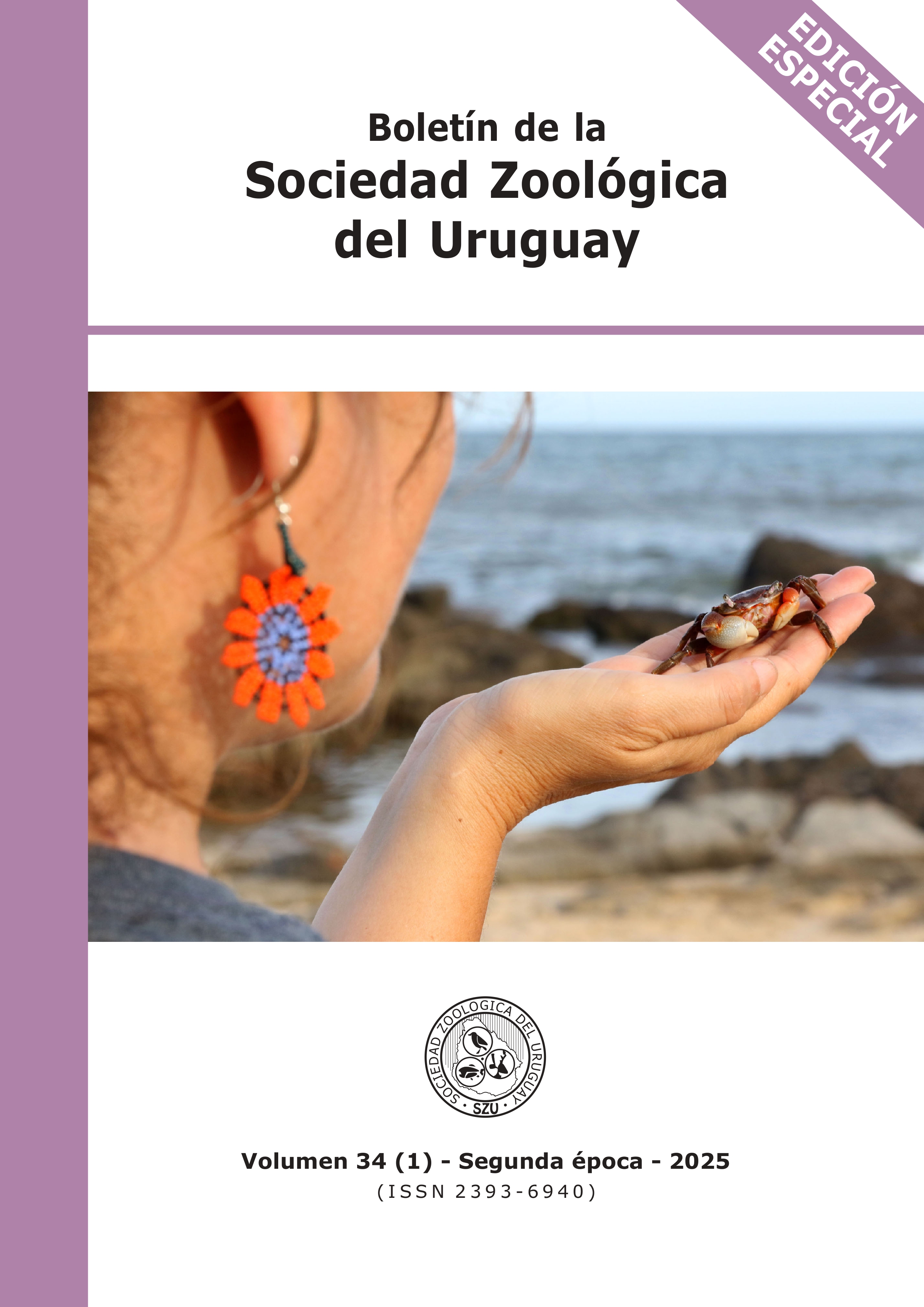FILOGENIA Y DIVERSIDAD GENÉTICA DE Paratrochosina amica (LYCOSIDAE: ALLOCOSINAE), UNA ARAÑA LOBO DE PASTIZAL
DOI:
https://doi.org/10.26462/34.1.12Palabras clave:
marcadores moleculares, licósido, NeotrópicoResumen
Paratrochosina amica es una especie de araña lobo de la subfamilia Allocosinae que habita en pastizales y jardines de Uruguay y otras regiones del sur de Sudamérica, donde presenta una amplia distribución. A diferencia de otras especies de esta subfamilia, P. amica posee tamaños corporales similares en ambos sexos y los machos son quienes buscan pareja activamente e inician el cortejo. Dado que se está intentado entender los factores que modelan los comportamientos sexuales y dimorfismo de tamaño en Allocosinae, los estudios en esta especie se vuelven clave. En este trabajo se amplía la representación de datos genéticos de estudios previos, incluyendo especímenes que abarcan una mayor parte de su distribución, y se infieren sus relaciones filogenéticas y analiza su diversidad genética. Los resultados del análisis filogenético corroboran la monofilia de Allocosinae y de P. amica, y ésta a su vez se ubica en la misma posición en el árbol filogenético como lo reportado previamente. La red de haplotipos sugiere una alta conectividad entre los individuos de las localidades estudiadas. Finalmente, el análisis de GMYC muestra que todos los individuos analizados pertenecen a un mismo linaje evolutivo.
Descargas
Citas
Aisenberg, A. (2014). Adventurous females and demanding males: sex role reversal in a Neotropical spider. En R. H. Macedo & G. Machado (Eds.). Sexual Selection: Perspectives and Models from the Neotropics (pp. 163-182). USA Elsevier.
Aisenberg, A., & Costa, F.G. (2008). Reproductive isolation and sex-role reversal in two sympatric sand-dwelling wolf spiders of the genus Allocosa. Canadian Journal of Zoology, 86(7), 648-658.
Aisenberg, A., Viera, C., & Costa, F.G. (2007). Daring females, devoted males, and reversed sexual size dimorphism in the sand-dwelling spider Allocosa brasiliensis (Araneae, Lycosidae). Behavioral Ecology Sociobiology, 62, 29-35.
Barth, F.G. (2002). A spider's world. Senses and behavior. Springer-Verlag, Berlin Heidelberg.
Bell, J., Bohan, D., Shaw, E., & Weyman, G. (2005). Ballooning dispersal using silk: world fauna, phylogenies, genetics and models. Bulletin of Entomological Research, 95(2), 69-114.
Bickford, D., Lohman, D.J., Sodhi, N.S., Ng, P.K., Meier, R., Winker, K., Ingram, K.K., & Das, I.J. (2007). Cryptic species as a window on diversity and conservation. Trends in Ecology and Evolution, 22(3), 148-155.
Bidegaray-Batista, L., Arnedo, M., Carlozzi, A., Jorge, C., Pliscoff, P., Postiglioni, R., Simó, M., & Aisenberg, A. (2017). Dispersal strategies, genetic diversity and distribution of two wo spiders (Araneae, Lycosidae), potential bioindicators of ecosystem health of coastal dune habitats of South America. En C. Viera & M.O. Gonzaga (Eds.). Behavior and ecology of Neotropical spiders - contributions of studies from the Neotropical region (pp. 109-135). Springer, Cham.
Bishop, L., & Riechert, S.E. (1990). Spider colonization of agroecosystems: mode and source. Environmental Entomology, 19(6), 1738-1745. BEAST 2.5: An advanced software platform for Bayesian evolutionary analysis. PLoS Computational Biology, 15(4), e1006650.
Brazeiro, A., Achkar, M., Toranza, C., & Bartesaghi, L. (2020). Agricultural expansion in Uruguayan grasslands and priority areas for vertebrate and woody plant conservation. Ecology Society, 25(1), 15.
Carlozzi, A., Bidegaray-Batista, L., González-Bergonzoni, I., & Aisenberg, A. (2018). Flying sand-dwelling spiders: aerial dispersal in Allocosa marindia and Allocosa senex (Araneae: Lycosidae). The Journal of Arachnology, 46(1), 7-12.
Clement, M., Snell, Q., Walker, P., Posada, D., & Crandall, K. (2002). TCS: Estimating gene genealogies. Parallel Distributed Processing Symposium, International Proceedings, 2, 184.
Colgan, D.J., McLauchlan, A., Wilson, G.D., Livingston, S., Edgecombe, G., Macaranas, J., Cassis, G., & Gray, M. (1998). Histone H3 and U2 snRNA DNA sequences and arthropod molecular evolution. Australian Journal of Zoology, 46(5), 419-437.
Croom, H.B., Gillespie, R.G., & Palumbi, S.R. (1991). Mitochondrial DNA sequences coding for a portion of the RNA of the small ribosomal subunits of Tetragnatha mandibulata and Tetragnatha hawaiensis (Araneae, Tetragnathidae). Journal of Arachnology, 210-214.
DeSalle, R., Egan, M.G., & Siddall, M. (2005). The unholy trinity: taxonomy, species delimitation and DNA barcoding. Philosophical Transactions of the Royal Society B: Biological Sciences, 360(1462), 1905-1916.
Dondale, C. (1986). The subfamilies of wolf spiders (Araneae: Lycosidae). Actas X Congreso Internacional de Aracnología, Jaca, España.
Entling, M.H., Stämpfli, K., & Ovaskainen, O. (2011). Increased propensity for aerial dispersal in disturbed habitats due to intraspecific variation and species turnover. Oikos, 120(7), 1099-1109.
Foelix, R. (2011). Biology of Spiders. Oxford University Press.
Folmer, O., Black, M., Hoeh, W., Lutz, R., & Vrijenhoek, R. (1994). DNA primers for amplification of mitochondrial cytochrome c oxidase subunit I from diverse metazoan invertebrates. Molecular Marine Biology and Biotechnology, 3(5), 294-299.
Fontaneto, D., Herniou, E.A., Boschetti, C., Caprioli, M., Melone, G., Ricci, C., & Barraclough, T.G. (2007). Independently evolving species in asexual bdelloid rotifers. PLoS biology, 5(4), e87.
Fu, Y.X. (1997). Statistical tests of neutrality of mutations against population growth, hitchhiking and background selection. Genetics, 147(2), 915-925.
Gonnet, V. (2022). Dimorfismo y comportamiento sexual en una especie de Allocosinae (Araneae, Lycosidae) de nuestros pastizales: un abordaje taxonómico, molecular y comportamental. (Tesis de Maestría), PEDECIBA. Facultad de Ciencias, Universidad de la República.
González, M., Peretti, A.V., & Costa, F.G. (2015). Reproductive isolation between two populations of Aglaoctenus lagotis, a funnel-web wolf spider. Biological Journal of the Linnean Society, 114(3), 646-658.
González, M., Peretti, A.V., Viera, C., & Costa, F.G. (2013). Differences in sexual behavior of two distant populations of the funnel-web wolf spider Aglaoctenus lagotis. Journal of Ethology, 31, 175-184.
Guerra, C.B., Ferretti, N., & Aisenberg, A. (2022). Testing sexual size dimorphism and nocturnal surface activity in the coastal wolf spider Allocosa alticeps. Arachnology, 19, 537-42.
Hedin, M.C. (1997). Molecular phylogenetics at the population/species interface in cave spiders of the southern Appalachians (Araneae: Nesticidae: Nesticus). Molecular Biology and Evolution, 14(3), 309-324.
Hoang, D.T., Chernomor, O., Von Haeseler, A., Minh, B.Q., & Vinh, L.S. (2018). UFBoot2: improving the ultrafast bootstrap approximation. Molecular Biology Evolution, 35(2), 518-522.
Kacevas, N. (2022). Dispersión, distribución y estructuración genética en Aglaoctenus lagotis: una araña lobo de tela prioritaria para la conservación en Uruguay. (Tesis de Mestría), PEDECIBA. Facultad de Ciencias, Universidad de la República.
Kalyaanamoorthy, S., Minh, B.Q., Wong, T.K., Von Haeseler, A., & Jermiin, L.S. (2017). ModelFinder: fast model selection for accurate phylogenetic estimates. Nature Methods, 14(6), 587-589.
Katoh, K., Rozewicki, J., & Yamada, K.D. (2019 ). Access the recommendation on F1000 MAFFT online service: multiple sequence alignment, interactive sequence choice and visualization. Briefings in Bioinformatics, 20, 1160-1166.
Laborda, Á. (2023). Taxonomía y sistematica de la Subfamilia Allocosinae (Araneae: Lycosidae) en Sudamérica. (Tesis de Doctorado), PEDECIBA. Facultad de Ciencias, Universidad de la República.
Laborda, Á., Bidegaray-Batista, L., Simó Núñez, M., Brescovit, A.D., Beloso, C., & Piacentini, L.N. (2022). Abaycosa a new genus of South American wolf spiders (Lycosidae: Allocosinae). Arthropod Systematics & Phylogeny, 80, 59-74.
Leigh, J.W., Bryant, D., & Nakagawa, S. (2015). PopART: full-feature software for haplotype network construction. Methods in Ecology & Evolution, 6(9), 1110e1116.
Lemey, P., Salemi, M., & Vandamme, A.M.E. (2009). The phylogenetic handbook: a practical approach to phylogenetic analysis and hypothesis testing. Cambridge University Press, New York.
Macías-Hernández, N., Oromí, P., & Arnedo, M.A. (2010). Integrative taxonomy uncovers hidden species diversity in woodlouse hunter spiders (Araneae, Dysderidae) endemic to the Macaronesian archipelagos. Systematics Biodiversity, 8(4), 531-553.
Nentwig, W., Ansorg, J., Bolzern, A., Frick, H., Ganske, A.S., Hänggi, A., Kropf, C., & Stäubli, A. (2022). All You Need to Know About Spiders. Springer Cham. Switzerland.
Nguyen, L.-T., Schmidt, H.A., Von Haeseler, A., & Minh, B.Q. (2015). IQ-TREE: a fast and effective stochastic algorithm for estimating maximumlikelihood phylogenies. Molecular biology evolution, 32(1), 268-274.
Piacentini, L.N., & Ramírez, M.J. (2019). Hunting the wolf: a molecular phylogeny of the wolf spiders (Araneae, Lycosidae). Molecular Phylogenetics Evolution, 136, 227-240.
Pons, J., Barraclough, T.G., Gomez-Zurita, J., Cardoso, A., Duran, D.P., Hazell, S., Kamoun, S., Sumlin, W.D., & Vogler, A.P. (2006). Sequence-based species delimitation for the DNA taxonomy of undescribed insects. Systematic Biology, 55(4), 595-609.
Postiglioni, R., Bidegaray-Batista, L., Simó, M., & Arnedo, M.A. (2019). Move to stay: genetic structure and demographic history of a wolf spider inhabiting coastal sand dunes of southern South America. Systematics Biodiversity, 17(7), 635-649.
Rambaut, A., Drummond, A.J., Xie, D., Baele, G., & Suchard, M.A. (2018). Posterior summarization in Bayesian phylogenetics using Tracer 1.7. Systematic Biology, 67(5), 901-904.
Ramos-Onsins, S.E., & Rozas, J. (2002). Statistical properties of new neutrality tests against population growth. Molecular Biology and Evolution, 19(12), 2092-2100.
Rozas, J., Ferrer-Mata, A., Sánchez-DelBarrio, J.C., Guirao-Rico, S., Librado, P., Ramos-Onsins, S.E., & Sánchez-Gracia, A. (2017). DnaSP 6: DNA sequence polymorphism analysis of large data sets. Molecular Biology Evolution, 34(12), 3299-3302.
Shorthouse, D.P. (2010). SimpleMappr, an online tool to produce publication-quality point maps. [Tomado de https://www.simplemappr.net]. Acceso 22/10/2024.
Simó, M., Lise, A.A., Pompozzi, G., & Laborda, Á. (2017). On the taxonomy of southern South American species of the wolf spider genus Allocosa (Araneae: Lycosidae: Allocosinae). Zootaxa, 4216(3), 261-278.
Simon, C., Frati, F., Beckenbach, A., Crespi, B., Liu, H., & Flook, P. (1994). Evolution, weighting, and phylogenetic utility of mitochondrial gene sequences and a compilation of conserved polymerase chain reaction primers. Annals of the Entomological Society of America, 87(6), 651-701.
Tajima, F. (1989). Statistical method for testing the neutral mutation hypothesis by DNA polymorphism. Genetics, 123(3), 585-595.
World Spider Catalog. (2024). World Spider Catalog. Version 25.5. Natural History Museum Bern. [Tomado de http://wsc.nmbe.ch]. Acceso 22/10/2024. doi: 10.24436/2











